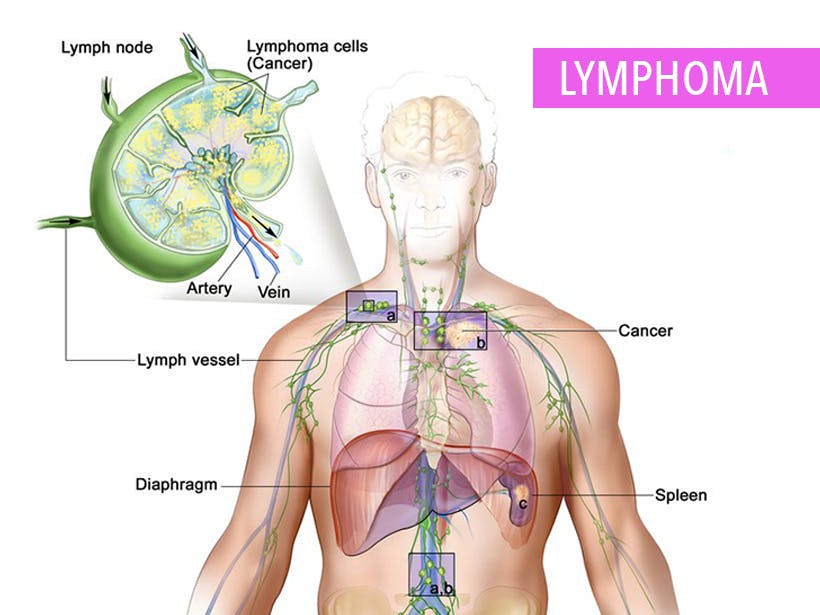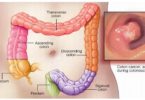What's in this article?
What is Lymphoma?
Lymphoma is a form of cancer that affects the immune system specifically, it is a cancer of immune cells called lymphocytes, a type of white blood cell. There are two broad types of lymphoma and many sub-types.
The two types of lymphoma are described as:
Hodgkin’s– Hodgkin lymphoma is a type of lymphoma, a cancer that starts in white blood cells called lymphocytes. Lymphocytes are part of the immune system.
Cancer starts when cells in the body begin to grow out of control. Cells in nearly any part of the body can become cancer, and can spread to other areas of the body.
Non-Hodgkin’s– Non–Hodgkin lymphoma (also known as non–Hodgkin’s lymphoma, NHL, or sometimes just lymphoma) is a cancer that starts in cells called lymphocytes, which are part of the body’s immune system. Lymphocytes are in the lymph nodes and other lymphoid tissues (such as the spleen and bone marrow).
Lymphoma can occur at any age but is the most common cancer in young people. It is often very treatable, and most people live for a long time after being diagnosed.
Even though lymphoma is cancer, it is very treatable. Many cases can even be cured. Your doctor can help you find the right treatment for your type of the illness.
Lymphoma is different from leukemia. Each of these cancers starts in a different type of cell.
- Lymphoma starts in infection-fighting lymphocytes.
- Leukemia starts in blood-forming cells inside bone marrow.
Lymphoma is also not the same as lymphedema, which is a collection of fluid that forms under the skin when lymph nodes are damaged.
How common is Lymphoma?
Lymphoma is the 5th most common male cancer and 6th most common cancer for female in Singapore, according to the Singapore Cancer Registry 2010-2014. There were about 686 cases reported yearly between the year 2010-2014. It is one of the most common cancer seen in children and young adults as well. It affects more men than women. Most adult patients develop lymphoma after the age of 50.
What Are Lymphoma Causes and Risk Factors?
There is no specific cause for lymphoma, but it has been closely associated with abnormally decreased immune systems that may be present from birth or associated with viruses such as the AIDS virus.
What Are Lymphoma Symptoms and Signs?
Often, the first sign of lymphoma is a painless swelling of lymph nodes in the neck, under an arm, or in the groin.
- Lymph nodes and/or tissues elsewhere in the body may also swell. The spleen, for example, may become enlarged in lymphoma.
- The enlarged lymph node sometimes causes other symptoms by pressing against a vein or lymphatic vessel (swelling of an arm or leg), a nerve (pain, numbness, or tingling), or the stomach (early feeling of fullness).
- Enlargement of the spleen (splenomegaly) may cause abdominal pain or discomfort.
- Many people have no other symptoms.
Symptoms of lymphoma may vary from patient to patient and may include one or more the following:
- Fevers
- Chills
- Unexplained weight loss
- Night sweats
- Lack of energy
- Itching (up to 25% of patients develop this itch [pruritus], most commonly in the lower extremity but it can occur anywhere, be local, or spreading over the whole body)
- Loss of appetite
- Shortness of breath
- Lymphedema
- Back or bone pain
- Neuropathy
- Blood in the stool or vomit
- Blockage of urine flow
- Headaches
- Seizures
These symptoms are nonspecific, and not every patient will have all of these potential symptoms. This means that a patient’s symptoms could be caused by any number of conditions unrelated to cancer. For instance, they could be signs of the flu or other viral infection, but in those cases, they would not last very long. In lymphoma, the symptoms persist over time and cannot be explained by an infection or another disease.
Treatment of lymphoma
Lymphoma treatment can include the following modalities:
Chemotherapy: A drug treatment given orally or injected into the hand veins to kill cancer cells. Each course of treatment is given at regulated intervals to allow the body to recover. The drugs circulate throughout the body to reach cancer cells even when they are widespread.
Radiation therapy: A localised treatment using high-energy rays to kill lymphoma cells wherever the rays are directed. The area may be confined to the affected lymph node or organ, or may encompass a wider area such as the neck, chest and under both armpits. This treatment can be administered alone or combined with chemotherapy.
Stem cell transplant: This procedure lets you receive higher doses of chemotherapy or radiation to kill cancer cells that may not be eliminated with standard doses. Healthy stems cells from your bone marrow (capable of producing new blood cells) are first collected and frozen. After a high-dose chemotherapy treatment which kills most white blood cells (including the healthy ones), stems cells are reintroduced into your body and help rebuild your immune system.
Biological therapy: A form of therapy using products to boost the body’s own immune system to fight the cancer. One example is the use of monoclonal antibodies. These antibodies attach themselves to B cells, making cancerous B cells more visible to the body’s immune system so that they can be destroyed. Although non-cancerous B cells will be targeted as well, your body is capable of replacing them. This form of therapy should only be considered when conventional treatments are deemed ineffective.






Leave a Comment